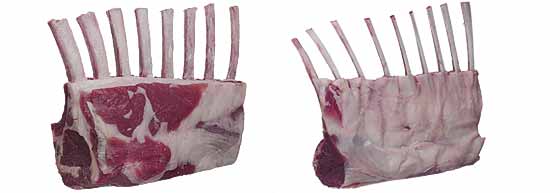
Spring lamb is an Easter and a Passover dinner-table tradition. Yet this is also the trickiest time of the year to buy it because supply is limited—the bulk of the new season isn’t available till May or June—and what is in stores will have been fed mainly grain, rather than grass, which makes for fattier meat. Most of what you will see is four-to-six-month-old Colorado lamb, and even that isn’t plentiful, so stores fall back on tougher, gamier ten-to-eleven-month-old lamb to make up the numbers. How do you tell the difference? Look for a smaller leg, which means the lamb is younger. Or seek out lamb from Australia or local small boutique farmers: They’re grass-fed, generally less mature, and more tender.
COLORADO
Characteristics
The most common American lamb is fed on grass prior to being plumped up on grain in feed lots for a few months. This produces a larger animal than a pure grass-fed lamb—up to 85 pounds—with well-marbled pinkish-red meat and a large eye nugget on the rib. The flavor is rich and mellow, but the meat can be fatty. Don’t pay much attention to the USDA-prime label: Only grain-fed lambs are fat enough to qualify, and lamb raised outside the U.S. is grass-fed.
Where to Get It
Eli’s Manhattan (1411 Third Ave., at 80th St.; 212-717-8100) or Lobel’s (1096 Madison Ave., nr. 83rd St.; 212-737-1372); also Citarella, O. Ottomanelli’s & Sons, Whole Foods
AUSTRALIAN
Characteristics
The next most plentiful lamb, after Colorado; 70 percent of it is shipped fresh. The animals are free of all growth hormones and 99 percent grass-fed (occasionally, a small amount of grain is used). The ten-month-old lambs weigh, on average, 40 to 50 pounds; the flesh is lean and pale pink, with a sweet mild flavor. The Australian lamb currently available has been raised under prime summer conditions, so it’s a good time to buy.
Where to Get It
O. Ottomanelli’s & Sons (285 Bleecker St., nr. Seventh Ave.; 212-675-4217) or Costco (976 Third Ave., nr. 39th St., Sunset Park, Brooklyn; 718-965-7603); also Citarella, Lobel’s
JAMISON FARM
Characteristics
This Appalachian boutique farmer supplies top chefs like Eric Ripert, Daniel Boulud, and Dan Barber; you can’t buy his lamb at the butcher’s, but you can get it by mail order. Jamison rears three-to-six-month-old Dorset cross lambs on grass, which adds seasonal flavor—in spring, there’s a hint of wild garlic—and makes them leaner, as the animals roam the hills to forage. Dry-aged for seven to ten days, the lamb is tender, sweet, succulent, and totally natural.
Where to Get It
Jamison Farm (mail order; call 800-237-5262 or go to jamisonfarm.com)
MILK-FED
Characteristics
The milk-fed, or hothouse, lamb produced by East Coast farmers is an Easter delicacy prized by many Europeans. The lambs are raised indoors, suckling their mother’s milk, and when they are mature enough to eat, they are fed a little grain. The animals are slaughtered at six to eight weeks, at a weight of 14 to 30 pounds, which produces a very tender, pale pink meat.
Where to Get It
Biancardi Meats (2350 Arthur Ave., nr. 187th St., the Bronx; 718-733-4058) or Citarella (2135 Broadway, at 75th St.; 212-874-0383); also Lobel’s, O. Ottomanelli’s & Sons
NEW ZEALAND
Characteristics
After Australia, New Zealand is the next big producer, although not as much of its lamb seems to end up on these shores—and 90 percent of what does get here is frozen. This all-natural pasture-raised lamb is small, with a carcass weight of between 33 and 40 pounds at four months. The meat is lean, pale in color, with a stronger flavor than Australian lamb.
Where to Get It
Whole Foods Market (250 Seventh Ave., at 24th St.; 212-924-5969); also O. Ottomanelli’s & Sons
Web Exclusive: Justin Bazdarich of Perry St.’s Rack of Lamb Recipe